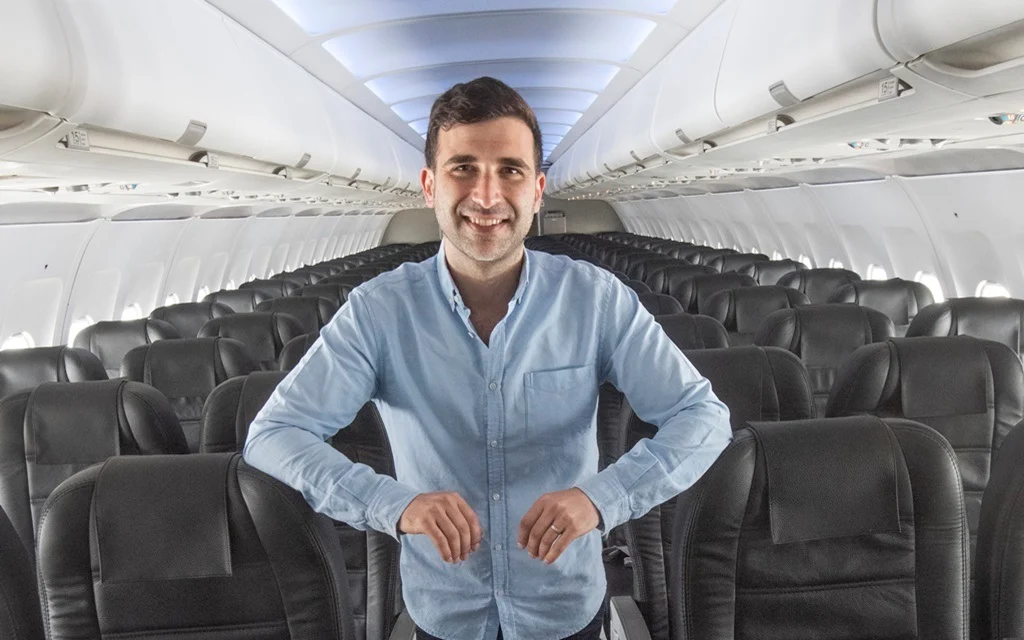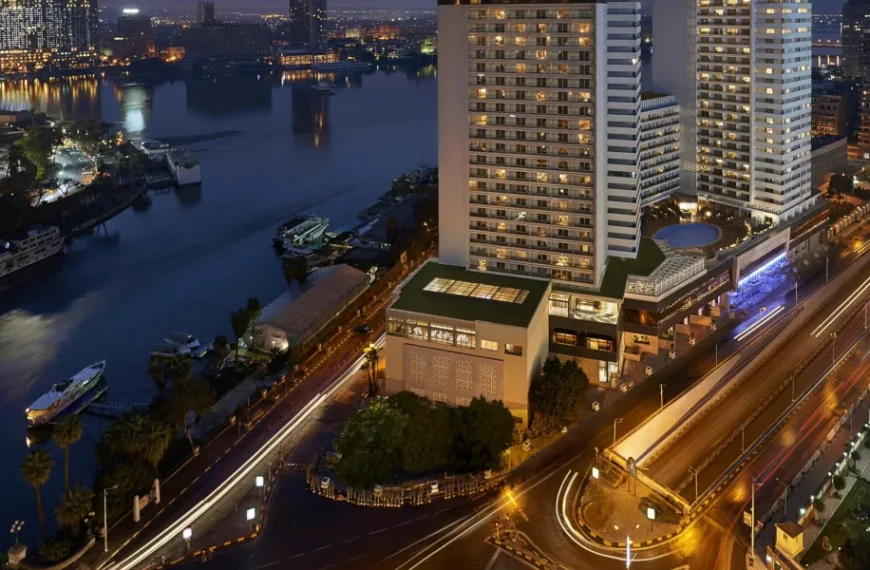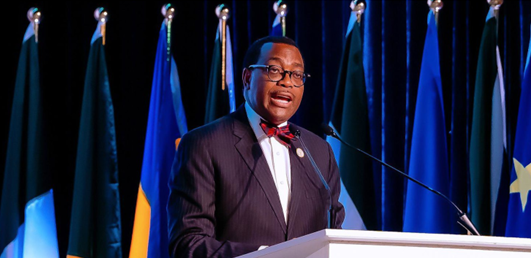
In Conversation: An Interview With Jonathan Ayache, CEO of Lift
Simple Flying recently sat down with Jon Ayache, CEO of South African airline Lift. Jon founded the airline in collaboration with experienced airline CEO Gidon Novick, and has led it through a turbulent but successful first 18 months. Below is the transcript of our conversation.
I’m delighted to have joining me today, Jon Ayache from Lift. He is the airline’s CEO and was one of the founders as well. So he’s been there since day one, setting up this really interesting South African carrier. Jon, welcome.
Jonathan Ayache
Thanks, Jo. Great to be here.
Joanna Bailey
Great to see you. So let’s go right back to the beginning to start this conversation. I know we want to talk about some more of the stuff that’s happening right now, but I just think your startup journey was so interesting, we’ve really got to begin there. Let’s begin with why you did it. You know, we were in the middle of a pandemic, and you thought, hey, this is a great time to start an airline. What was the opportunity you saw there?
Jonathan Ayache
My background is not in aviation. I was at Uber for seven years and was leaving that that part of my career behind me and decided to go and pester Gidon Novick, who was previously the CEO and the founder of kulula.com, South Africa’s first low-cost carrier. I wanted to ask him for his advice, and we chatted for a while, and he said, “I’m thinking about starting an airline, do you want to come to a meeting?” And I said yes. And then that kind of spiraled into me jumping in full-time, knowing very little about the industry. And that’s probably a good thing, because the less you know, the less there is to kind of sound the warning bells in your mind about what could go wrong.
It’s been an absolutely incredible journey over the last almost two years. Now, the best analogy that someone said right at the beginning was it’s going to be like drinking from a firehose, in terms of the learning and upskilling that’s going to be required. And I couldn’t agree more.
Joanna Bailey
I can imagine it was a very steep learning curve for you. And you didn’t do it the easy way. I mean, most people, they, they maybe buy some assets, or you know, they acquire a few bits and pieces and kind of start slowly. And it takes maybe two or three years before that airline takes its first flight. You guys did it in 90 days. Just tell me how that worked, and why, you know, why were you in such a hurry?
JA
So we launched the business fairly quickly from first meetings to our first bookings and first flights. And that was partly because COVID gave us a really unique opportunity in South Africa at the time. SAA was not flying, and neither was Comair – Comair had been grounded as well. And so there were these two huge carriers that previously made up the bulk of South Africa’s domestic market. And we saw this opportunity to launch and scale up or scale fairly quickly without them there.
In addition to that, because so many aircraft were parked, and there was so much talent available, we were able to get really flexible, operating leases, and hire some exceptionally talented people. And so this, this all kind of coalesced, and the timing just made sense. And so we entered the markets, our first flight was in December 2020, right in the heart of the pandemic. And it was really exciting, but at the same time, Comair came back and started flying again, subsequently, SAA did as well – we knew that was a possibility, but it was the reason we wanted to rush and get in there.
The route that we decided to operate first was also an important part of it, which is the Johannesburg Cape Town route, which is one of the busiest routes in the world, and also quite resilient. Even though we were in the middle of COVID, we knew that if any route was going to be able to sustain us through the different waves that we had, it was going to be this one, which had a good mix of leisure and even though there wasn’t a lot of business travel it still had some of that on the route. And so it was all of those things that kind of pushed us into that timing.
JB
Incredible. Just goes to show it can be done. And so you talked a little bit about the planes that you were able to access because of the pandemic there. And of course you settled on the Airbus A320. Was there a particular reason that was chosen as the basis for your fleet?
JA
Part of Lift’s success is down to Global Aviation, who previously were doing (and have been for the last 20 years) ACMI and charter operations. Obviously, their business was also impacted by COVID, and their planes were not operating. And so it was an opportunity to create Lift as a business line and a brand that they operate as a domestic scheduled service. So it wasn’t that we went out to find an Airbus but that they operated them. And they’re fantastic aircraft, I think, in terms of the reliability that we’ve been able to achieve in the first two years of operating – it has been phenomenal. That’s partly because of the aircraft and partly because of the team that’s operating them. So over 90% on time performance in our first two years of operating, which is no small feat for a brand new airline, and something we’re really proud of,
JB
Particularly given the current conditions… we’ll come back to this summer, and how that’s been in a minute. But I just wanted to talk a little bit about the brand and the kind of what makes Lift different, I know you guys really set out to do something a bit differently to your competition. What is it you think is your unique selling point as an airline?
JA
I think what’s happened over time, and this is a bit of a generalization, but airline travel has become a commodity. Everyone is focused on driving the costs down and offering as little as possible. And what we were able to do, by entering the market at this really unique point in time, was build a really low operating cost base. Now, that doesn’t mean we’re a low-cost carrier – I think the right term for it is hybrid – but we sit somewhere in the middle.
We’ve got this low operating cost base, but we offer a huge amount of value. So you don’t pay for snacks and food on board. We’re not trying to charge you for baggage and for every little thing to drive up our ancillary revenue. There’s a fare that’s charged, and it’s not always the lowest price, but you get significant value for that. And core to that value proposition is our complete flexibility – that was something we set out to do, and it was especially relevant during COVID, where it was extremely stressful and challenging to fly. You never knew if you were going to be in quarantine when you booked these flights. So we offer complete flexibility – you can change or cancel your flight up until 24 hours before free of charge as many times as you want. And so that was kind of the core of the value proposition.
But really I think the philosophy is what can we do to put customers back at the center of our decision-making, as opposed to treating them as just the person that’s buying your ticket? And can we extract as much out of them off every ticket as possible?
JB
That’s great to hear. And I think it’s an emerging trend in other markets as well. We’ve seen a few airlines going for this high service, but still good value fare proposition, and I’m glad to see it, you know, I think we’re kind of sick of being treated like cattle and everything you do, you’ve got to swipe your credit card for so it’s great to hear. And I know you guys do offer a premium cabin as well now, which is more like a premium economy than a business class, I would say. But that’s not something you started with. That’s something that was added later. Am I right?
JA
Yes. So it is, in the context of domestic travel, it is equivalent to a business class. And I mean, it’s certainly not like a QSuite or what you would expect in terms of business or first class for international travel, but it competes in the business class space domestically in South Africa.
I suppose it talks to that need and the value proposition that we saw in the market where there was definitely a demand for something more in terms of the service and quality and what was being offered in the market. And part of that was because, towards September ’21, SAA, which had a lot of the business class travel, and Comair, they weren’t back in full force yet.
So there was a gap that we filled and there was a lot of demand – people loved the service, but they wanted a premium or business class offering. So we launched that, and it further speaks to that differentiation. We’ve got industry-leading legroom throughout the cabin and in premium, and the service is going to be as friendly – there’s no difference in the people that are serving in premium. There are really delicious snacks, open bar, and complete flexibility. So even if you miss your flight, we’ll refund it. And there are no penalties or anything for premium. So it further goes to that hybrid model as opposed to a low-cost carrier.
JB
That’s really good to hear. You guys have some fun with this customer experience as well, don’t you? I mean, I’ve seen, what have I seen recently, bingo onboard, live music, silent disco… flying with you guys is fun, right?
JA
It kind of speaks to the personality of the brand, which is really driven by the people. And we like to come to work and have fun. I mean, it’s stressful a lot of the time because we’re trying to move a lot of people, and we really take that seriously. We hate it if there are delays, or if we’ve impacted a passenger who’s traveling with us. But there’s so much fun that we have.
A lot of these suggestions actually come from feedback we get from customers. So there’s a QR code that we’ve got at the back of our seat where we asked for feedback. And some of the early feedback we got was can we travel with our pets, and being pet lovers ourselves at Lift, with we thought, how can we do this? And now we actually offer a service where you can fly with your small dog in the cabin with you. And that’s one example.
We’ve done bingos, as you said we’ve done a silent disco. So everyone had headphones, and we had a live performance at the front of the aircraft. And these were all just fun things that either the team have come up with or what’s come through feedback that we’ve had throughout our customer feedback surveys.
JB
That’s fantastic and great to see as well that you’ve got that flexibility to add some of these things people are asking for. So let’s talk about how things have been few so far. Lke you say, you started in a bit of a void in the South African market, and things kind of picked up again. But we’ve seen more disruptions this summer, Comair having some problems and other carriers disappearing out of the market… How’s the demand for your services been? Are you flying with full planes?
JA
We’ve been flying with full planes from fairly early on. I think the team has done a fantastic job even in the COVID period where we’ve been able to achieve load factors in the 90s. And so that’s been great. I think the challenge the industry in South Africa has faced specifically, which was that the yields and the fares that have been we’ve been able to charge have not been where they need to be to offset what’s been an increasing fuel cost over the last 18 months, and I think that’s been the primary challenge. So for one, there’s been an increase in these input costs.
And it’s not just fuel in South Africa, we’re also exposed to the rand-dollar exchange rate, and the two biggest costs we have are fuel and our leases. And so when that swings, we feel that quite acutely. And then, at the same time, there hasn’t been a proper recovery yet in domestic travel. Where we sit today is that, domestically, we’re at about 70% of the passenger volumes when you compare to 2019 and pre-COVID.
And so it’s those two things that have made it really challenging. With the Comair closure, there’s been an opportunity to rationalize a bit. And that is a bit of a short-term swing where it went from very over-supplied to a little bit more under-supplied. And that allowed us to pass on those increased fuel costs, the increased costs because of the rand-dollar exchange rate. Now we’re entering a more sustainable period, which allows us to say, Okay, what does expansion look like for us?
JB
Great. On the fuel topic before we go into your expansion, we’ve been hearing a lot about fuel shortages across Africa, particularly in Nigeria, but I do believe it’s hit South Africa as well. Have you guys been impacted by that at all?
JA
There’s a challenge that we’re facing at the moment in Cape Town, which is driven by the fact that a lot of the refinery capacity in South Africa has disappeared. And I don’t have the exact statistics but is the refinery in Cape Town hasn’t been operating for a while. We’re hoping that that will come online this year. There’s reduction in capacity in Durban and Johannesburg, and so what that means is that a lot of, or almost all the fuel we need is imported. There’s been a disruption in that, and there’s been a delay in that arriving.
With the increase in capacity that we’ve had, there’s actually a shortage in Cape Town, which we’re managing. We’re doing a lot of tankering out of Johannesburg, which again, increases our operating costs, but the alternative is not viable – we can’t not operate. The last thing we want to do is reduce the number of passengers that we’re able to fly and disrupt them because we need to tanker fuel. So it is something we’re dealing with.
We’re hopeful that with better planning and better coordination with the stakeholders involved, it’s something that’s avoidable, moving forward. But it’s just one of those other things that, as a passenger, you don’t necessarily think about, but it’s something that we face, and we have to manage.
JB
Yeah, absolutely. And, of course, having an environmental impact as well, flying heavier than you need to. So bad news all round, but hopefully something they’ll get resolved. So now you are looking towards expansion. I know you’ve been plying that Cape Town Johannesburg route for the longest time, and now, we’re really excited to see you’re going to Durban – what was the impetus behind this? I know it’s a popular area. But did you see a lack of competition that inspired you to launch that route?
JA
Well, the joke internally is we were just tired of hearing that as the question that we got almost every post we do on social media was, ‘When are you launching Durban?’ No, but it’s really been on the cards for a while. For context, if you look at this domestic aviation market in South Africa, Joburg, Cape Town, is probably half of all domestic passenger volume. When you add in Durban and the routes between Johannesburg-Durban and Cape Town-Durban, you’re probably close to 75% of passenger volumes.
And so connecting that, which is known as the Golden Triangle, you’re tapping into the majority of the domestic market in South Africa. And I think in the case of aircraft that we operate, that was always going to be on the cards. And the real reason we haven’t done it up until now was because the sustainability and the stability of the market hasn’t been there. And the last thing you want to do is launch a new route, which comes with upfront investment, not knowing that you can recover those costs or that you’re going to be able to operate it profitably.
So with where things are today, we do see sustainability in the short to medium term. And we’re hopeful that, as an industry, we can behave more responsibly and grow into the recovery as we go back to normality.
JB
Absolutely. And that’s launching late October, is that right, end of the month?
JA
Bookings have opened, and our first flight is scheduled for the 26th of October – that is between Johannesburg and Durban. We’re expecting, in addition to the new route, we’ve got two more aircraft that have arrived, and we’ve got another two that should be arriving before the end of the year. And as soon as you’ve got exact confirmation of when those two are going to be landing in South Africa, we will be opening the Durban-Cape Town route as well. So there’ll be two new routes and four more aircraft on the side of the year, and then, excuse the pun, but the sky’s the limit as we head into 2023.
JB
That’s exciting. So you guys, I know you’re operating for quite a long time with just two, does this bring your fleet size to six by the end of this year?
JA
We’ve operated with two as a base, and we’ve flexed up to three a few times in the last 18 months. This will take us to six. And we’re doing it on a flexible basis. Global operates in Europe as well, and we are leveraging the aircraft that they operate in Europe in South Africa. If everything goes well, we can extend those aircraft, but if we see that there is a downturn or for any reason, it’s not sustainable as we go into our winter period, we can then share those back and send them to Europe during their peak season. So when we speak about our flexible operating model, it’s very practical at the same time.
JB
It’s a very different way of doing things rather than signing these like 10-year leases and having to find places to fly those planes regardless of what the market conditions are, it seems a very different way of going about things and much more, much more reactive. So great way of planning things, I guess, would they come liveried as Lift then if they’re potentially going back again? Or do you often fly with kind of plain aircraft as well?
JA
No. So we’ve had to kind of be a little bit practical about how we go about it. There will be livery; it won’t be the full livery that we have on our existing aircraft, but it will still look fantastic. And the team are putting that in place at the moment. Where we have had to compromise a little bit is, for example, some of the seat coverings we haven’t been able to do, we haven’t been able to change. Not that there’s anything wrong with them, but it’s not going to be the same exact seats or seat covering that we’ve got on our existing aircraft. There will be the same legroom across the aircraft. But those are the kinds of compromises that we’ve had to make, considering that these aircraft may go back at some point.
JB
Hmm, fair enough. Well, as long as the seat’s comfy and the legroom is the same, I think your passengers will be very happy. So, you know, looking a bit further ahead, maybe there is a plan to launch any more domestic routes? You know, I think you guys did tinker with one other destination, way back at the start, but it didn’t stick? Do you think you’d go back there?
JB
So we operated between Johannesburg and George in the first couple of months; that was always planned to be seasonal. And we may look at it. The challenge with George is it’s very directional. And so it does become challenging to keep that sustainable throughout the year on the gauge of aircraft that we operate. Provided we believe the routes are commercially viable, we will look to operate there. We must just prioritize and look at where the volumes are, and work from there. We’re always looking at where those opportunities are, but Durban was the most obvious next step, just given the volumes.
JB
Absolutely. It’s very interesting to hear how you’re targeting these kinds of high-demand routes. And a lot of the startups that we’ve spoken to over the last year or so they’ve started with a view to doing the underserved routes or the completely unserved routes. And it’s really interesting that you are happy to go out there and compete with the big boys, does this signal that there is still a lack of capacity in the South African market overall, taking into account the carriers that have disappeared or slimmed down, there’s still room for you is what I’m trying to say?
JA
I think so. And especially on the Golden Triangle, it’s very robust, because it’s got that mix of leisure and business. And it’s the three economic hubs in South Africa. On some of the underserved routes, it would be difficult for us to operate with the gauge of aircraft that we’re using, because you kind of got that trade-off between not having the frequency that you need to be competitive, or not filling up your aircraft. And I think that’s kind of where the challenge will be. And so we’ll look at those.
But we’re also geographically not ideally positioned as when you compare some of the other airlines that are operating in Europe, and there’s just this abundance of choice of where you fly, and the routes that you’ve got access to. So we’ve kind of playing with a bit of where our volumes are. And the fact that we’re just on the lower at the tip of Africa. And how do we balance those two things?
JB
You are a little bit down at the end of the world down there. I do get what you’re saying with the lack of opportunities. Would you ever look to fly outside of South Africa to open up more opportunities? Is that in the plan?
JA
Absolutely. I think the regional opportunity and Africa as a whole has so much untapped potential. It’s not just in aviation, I think, more broadly speaking, there is something very special about the continent. And I think air travel and creating connectivity is one of the things that is going to help us unlock that potential. Right now. It’s really challenging to get from South Africa, or from anywhere in Africa, from one country to another. And part of that is it’s expensive, and it’s really difficult to get route rights, and we’re definitely looking at that. And maybe it happens next year; maybe it happens the year after that.
But I think one of the things that’s important, and I think as the aviation industry, we need to push for, is to open up the skies and to make it easier for people to connect. Because the benefits are not just for the airline industry, but I think for the continent and business and people as a whole; there’s so much opportunity here. So, definitely looking at the region. And there are some really interesting routes that we, if we can get the route rights, and if we can get the right partners on the other end, we would like to operate.
JB
Exciting, that’s really good to hear. I can’t wait to see the announcements. But I get what you’re saying about traveling in Africa. I mean, you know, when I came down to Cape Town earlier in the year, it was a case of transferring through Addis or paying three times as much to fly direct from London; I won’t name any names or point any fingers. But the fare costs on those routes are ridiculous. But thinking about the kind of inbound traffic and how you could maybe be a bit of a feeder airline. You know, British Airways just lost its key South African partner that it kind of counted on to bring passengers to its hubs to fly them back to Europe. Do you see any partnerships with kind of international airlines being in your future? Would that be a benefit to you guys?
JA
Yeah, absolutely. And I think there are a couple of steps that we need to get right internally as a business. So right now, we’re not directly in the GDS. So we’re there through some of our other distribution partners, but it does make formal interline or codeshare arrangements more tricky. Obviously, there are other ways of doing that, and we’re exploring them. But you know what, the truth is, to this, at this point, where, to the point we’ve got to today, we’ve been so focused on accessing distribution more domestically, which has been the majority of where our business has been coming from. And it’s only at this point today that international travel is kind of being unlocked again, and these carriers are flying back into South Africa, and, interestingly, into both Cape Town and Johannesburg. So there’s definitely an opportunity. We are working on it as we speak. And hopefully, we can set up some great partnerships with the international carriers flying to South Africa.
JB
And that was a conscious decision to stay off the GDS, wasn’t it? I know you guys had a very digital-first mentality. And I think this is part of the thing of you coming into the business as a non-aviation person, you looked at all our legacy systems. And went, hold on, there’s a better way to do this. Has that all been working for you? Well, and you know, you’re getting great customer feedback on this. It’s a wallet, a digital wallet that you use, isn’t it?
JA
Yes, it’s been an interesting balancing act. There are obviously many things that are done in the industry for very good reason, but there are also things that aren’t necessary to be done. We’ve got a great mix in our team of aviation experts and people with a lot of experience, and people that are completely new to it like me. Not being afraid to ask what often are my silly questions like, ‘Why do we need to do X, Y, Z,’ sometimes they come back and say, Jon, just leave it; there’s a reason. And other times, it drives some further exploration, and we change things.
So the wallet that we’ve developed is a great facilitator of our flexibility. A lot of the time, you pay an arm and a leg, sometimes you can pay as much as two or three times what a normal ticket will cost, to guarantee flexibility, and then you only get a voucher if you cancel. And that voucher is sitting in an email somewhere, you lose it, it’s not valid for very long … the wallet that we developed is to facilitate real, seamless flexibility. So you go online the same way as you would manage your booking, you click cancel, and then instantly, the money is in your wallet, which you can use to rebook
It’s an example of something in a principle we took kind of from Uber and the way that we handled the customer experience there, and tried to bring it into the world of aviation. It’s just one small example that we’ve tried to implement.
JB
That’s fantastic. And I think, you know, it’s so something is refreshing to see a different approach to doing this than the usual GDS-based, like you say, get a voucher that you lose, or it goes out of date. So fantastic. And the customers enjoy your service. So you’re getting good feedback on your approach to aviation?
JA
I think so. I think the main metric is are we filling up our planes, then are we getting mostly good feedback? And I think the answer is absolutely, yes. It’s something we are very mindful of as we grow; it’s not something that we take for granted. And it’s something that, as a company and as our entire team, we sit and think about – how do we not lose this culture and this ethos and focus on keeping customers front and center as we almost double our team in a very, very short space of time.
So that’s what we’re actually going to be focused on, at the same time as bringing on the additional aircraft and the new route. Because if we, if we can get that, right, I think that’s the thing that we are going to be known for. And our goal is really, we know that we might not always have a seat for you, we may not always have a time that’s convenient for you. But our goal is really we want to be the first airline that you go and try and fly with, and we want to be people’s favorite airline. And I think in terms of that, we are on our way.
JB
Great stuff, a different sort of airline, I think, and, Jon, it’s been lovely talking to you this morning. Best of luck with the Durban route. Just to finish off though, I’m sure a few people that are watching along today have noted that you are an ex-Uber man, and you called your airline Lift. There’s a very popular ride-hailing service in some parts of the world that is also called Lyft. But you know, you guys actually threw that out to the public to bring that name to you, didn’t you? So it’s not entirely your brainchild. But I was thinking you must have had some really weird names submitted as well. Can you remember any of the also-rans?
JA
It’s been a while now. We tried to come up with a name, but we couldn’t come up with a good name that everyone liked. And so Gidon, who’s our co-founder, had the brilliant idea of putting it out to South Africans. We got, I want to say, 25,000 suggestions, and what are some of the funny ones… Planey McPlaneface – there were loads of funny ones, some that are not appropriate to share publicly. But loads of funny suggestions. And the one that resonated with the team as a whole was Lift.
At the time, I wasn’t sold, for exactly that reason. For me, Lift was Lyft in the US. But it has grown on me. And actually, because Lyft was not a thing in South Africa, or in Africa really, there hasn’t been that much confusion. And for me now, when I see Lyft, the connotation is the other way.
JB
Well, Jon, it’s been great to talk to you. I hope that new route launch goes brilliantly and I’m really pleased to see your fleet growing. Please do stay in touch and I hope we can catch up again soon.
JA
Thanks, Jo. That’d be great. All right.
JB
Thanks very much.
JA
It’s a pleasure.
Source:Simple flying



















